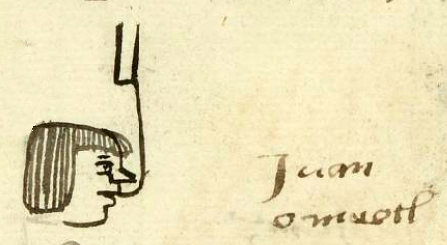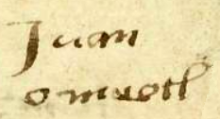Omeyotl (MH630r)
This black simplex glyph and notation stands for the personal name Omeyotl ("Dualism," or having the quality of two, attested here as a man's name) consists of two vertical lines connected at the bottom with a horizontal line.
Stephanie Wood
Names that involve numbers may have once been calendrical/divinatory names that would have combined a number up to 13 with one of twenty day signs. Macuilli might be one of those names, for example. But here, there is the added value of (-yotl), having that character. Nauhyotl ("Four-ness") is another one like Omeyotl, and much more common. Four involves a symmetry that is pervasive in Nahua culture. For example, four pairs of two lines is a recurring pattern in songs (see Lockhart, "Postconquest Nahua Society," Estudios de Cultura Náhuatl 20 (2022), 101). Lockhart has also pointed out how four echoes the cardinal directions and how symmetry was notable in altepetl organization.
Stephanie Wood
1560
Jeff Haskett-Wood
dos, números, nombres de hombres

ome, two, https://nahuatl.wired-humanities.org/content/ome
-yotl, having the nature of, https://nahuatl.wired-humanities.org/content/yotl
Dualidad, o Teniendo la Naturaleza del Número Dos
Stephanie Wood
Matrícula de Huexotzinco, folio 630r, World Digital Library, https://www.loc.gov/resource/gdcwdl.wdl_15282/?sp=342&st=image.
This manuscript is hosted by the Library of Congress and the World Digital Library; used here with the Creative Commons, “Attribution-NonCommercial-ShareAlike 3.0 License” (CC-BY-NC-SAq 3.0).






